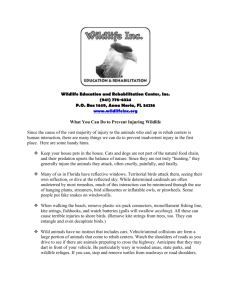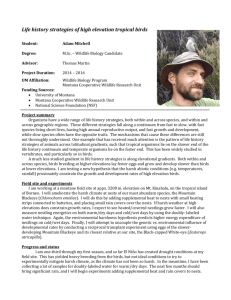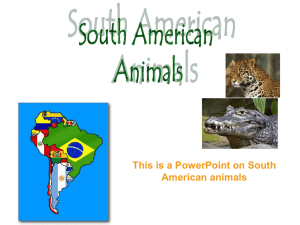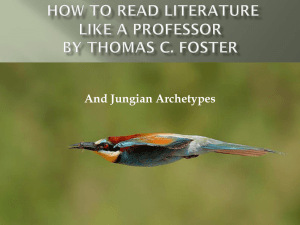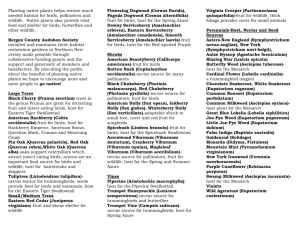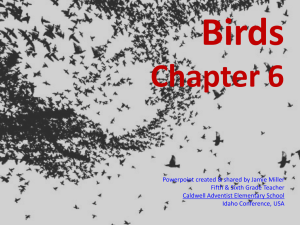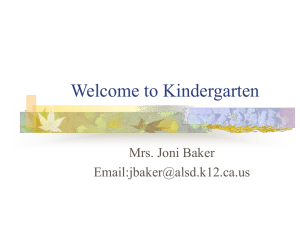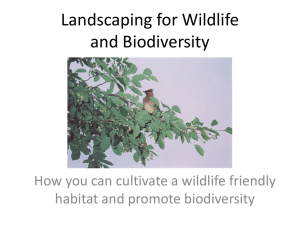Dr. Deborah M. Finch - NSTA Learning Center
advertisement
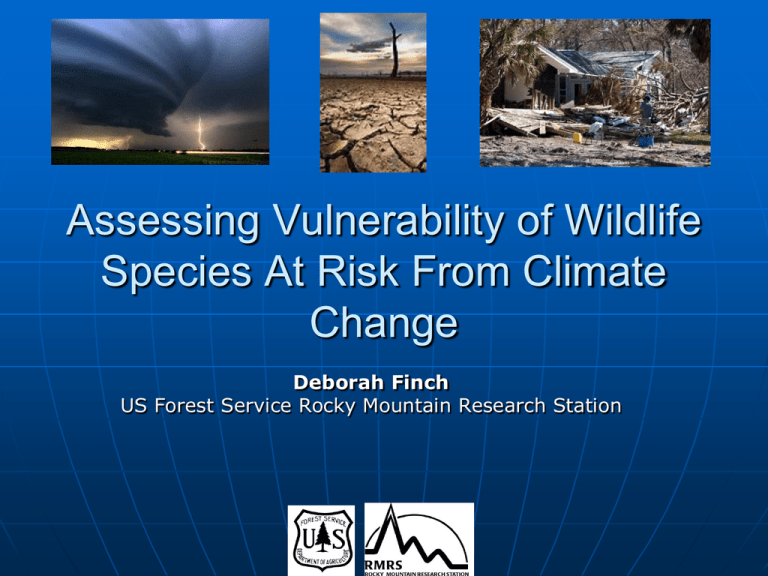
Assessing Vulnerability of Wildlife Species At Risk From Climate Change Deborah Finch US Forest Service Rocky Mountain Research Station What do we know about wildlife? How does climate change threaten wildlife? How will different species respond to climate change? Are species already responding? How will habitats be impacted? Where will impacts be greatest? IUCN Threatened CC susceptible Threatened & CC susceptible Total Birds = 38% (~ 3 x’s more) Foden et al. 2008. IUCN. Direct vs. Indirect Effects Direct effects of temperature, ppt. & carbon dioxide on birds (dehydration, egg-warming …) Indirect Effects: Habitat loss and shifts in habitat distributions Responses by invasive species Changes in fire frequency Diseases Changes in phenology Disruption of food webs Decoupling of cues and responses Migration times are shifting Birds are migrating earlier in the spring. A study of 63 years of data for 96 species of bird migrants in Canada showed that 27 species arrive earlier, in conjunction with warming spring temperatures. Birds also seem to be delaying fall departure: in a study of 13 N. Amer. songbirds, 6 species were found to delay their departure dates in relation to warming. Some birds in Europe are even failing to migrate at all. Egg laying is earlier. One large-scale study showed that birds are laying eggs at an average rate of 6.6 days earlier per decade. The Common Murre in North America has advanced its breeding date 24 days per decade. North American Tree Swallows are nesting up to 9 days earlier than 30 years ago, corresponding to an increase in average spring temperatures. Reproductive Timing Temperature cues and climate change can lead to earlier lay dates. Benefit or potential mismatch? Dunn and Winkler 1999. Proc. Royal Soc. Lond. 266 Mixed Signals Pied flycatcher in Holland • Long distance migrant • Migration triggered by day-night cycles • Food source tied to temperature • >90% reduction in populations (early breeders doing ok) Nicole Bouglouan From: University of Montanta 2009. Climate change hurting hares: with snowshoe hares can’t hide on brown earth. SciencDaily. Both et al., 2006 Nature Bird Distributions are Changing Bird populations are expected to shift poleward, or to higher elevations, to stay coupled to shifting environments as the climate changes. Ontario Breeding Bird Atlas data show “southern” bird species such as Tufted Titmouse and Blue-Gray Gnatcatcher have increased and have expanded their range north compared to 20 years ago. A study of 35 North American warbler species found that ranges of 7 species shifted significantly north in the past 24 years, by an average of 65 miles. None of the birds shifted to the south. 35 Temperature (°C) Shifts in elevational distributions: Mountain Quail 30 Maximum temps r2 = 0.4779 25 20 15 Minimum temps r2 = 0.0674 10 5 0 1960 1970 1980 1990 2000 Year Cumulative abundance 1.00 0.80 0.60 1979-81 K-S test: 2005-07 0.40 P < 0.05 0.20 0.00 200 700 1200 Elevation (m) Hargrove and Rotenberry 2009, UC Riverside 1700 2200 Ecological communities are disrupted Global warming can change entire ecological communities. Food and nesting materials may no longer be there. Wildlife may face new prey, parasites, competitors, and predators to which they are not adapted. Example of disruption Tufted Puffins at Canadian sites have breeding success near zero when water is at its warmest, which could mean that Canada’s largest breeding colony for this species, Scott Islands, may become unsuitable for Tufted Puffins as water continues to warm. Biotic Interactions: Disease Native bird populations decimated by avian Malaria Malaria limited by mosquito-vector Predicted range expansions due to global warming shifts birds into the unprotected malaria zone From: Benning et al., 2002 PNAS 99: 14246-14249. Weather phenomena Intensity and frequency of El Nino storms expected to increase. Drastic population crashes of the Black-throated Blue warbler have been linked to reduced precipitation in its over wintering grounds Increased El Nino events associated with 50% decline in Galapagos penguin populations Drought & Reproductive Failure R. Wolf Bolger, Patten, and Bostock. 2005. Population Ecology 142:398-406 How Are People Affected? Changes in recreational opportunities such as photographing and viewing animals Changes in ecosystem services such as water supply, wood products, clean air Changes in services available on public lands (skiing, rafting, camping) Extinction risks are on the rise Birds most at risk of extinction from climate change are those with restricted ranges, poor ability to move their range, small populations, or those already facing conservation challenges. Migratory birds are particularly vulnerable to climate change effects, because they depend on multiple habitats and sites. Arctic birds are particularly vulnerable – warming is occurring rapidly here, and 15% of the world’s birds breed in global Arctic regions. Vast areas of habitat, including tundra and sea ice, will be lost. Sea ice retreat could have severe consequences for Ivory Gulls, which forage on along sea ice. Canadian Ivory Gulls, which forage along sea ice, have already declined in number by 90% over the past two decades. Source: Koopman et al.2009 NCCSP Next Steps • Model demographic responses of species to changes in climate • Plan for future changes in critical habitats • Determine vulnerable wildlife species • Make assisted adaptation plans • Partnerships to achieve successful outcomes • Increase resilience of habitats via restoratlon • Monitor and analyze existing monitoring data • Conservation education Climate Change, Wildlife and Wildlands: A Toolkit for Formal and Informal Educators http://www.globalchange.gov/climate-toolkit The kit is designed for classroom teachers and informal educators and is aimed at the middle school level. The U.S. Environmental Protection Agency, in partnership with six other federal agencies, developed the kit to aid educators in teaching how climate change is affecting our nation’s wildlife and public lands, and how everyone can become “climate stewards.” Toolkit • 12 minute video on climate change, wildlife • Overview of the science of climate change • Case studies on impacts to habitats and wildlife • Glossary of climate change terms • Activities keyed to natl. science standards • Hands-on activities and educator resources Thanks USDA Forest Service University of Arizona Arizona State Polytechnic The Nature Conservancy Department of Defense, Legacy US Fish and Wildlife Service

